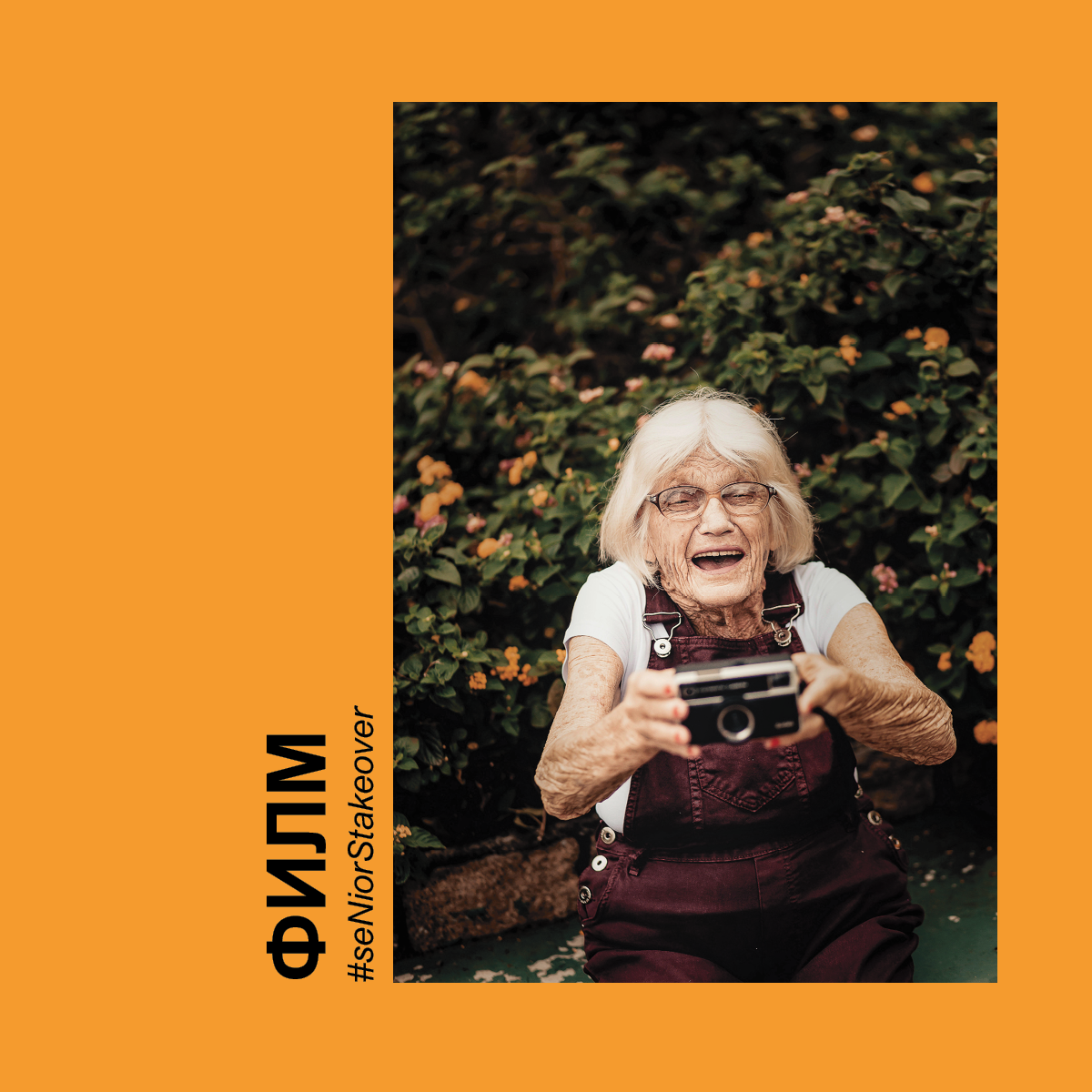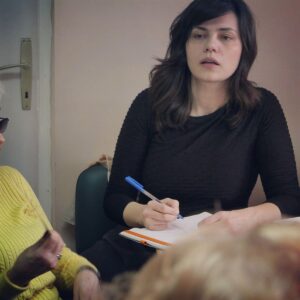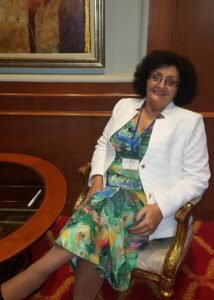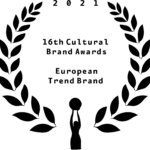‘They tried to look less than 65 so that they could at least get some fresh air. They would go out wearing vibrant colours, big sunglasses and their hair down. Dragan couldn’t stand being in his flat anymore, so he would sit in his car in front of the building, listening to music and playing the guitar. The police was watching him, but he didn’t care, he wasn’t disrespecting the Prohibition on Movement,’ this is just one part of the whole story of the #seNiorStakeover project, which the audience will have a chance to see as a short film, on the Facebook page of Cultural Station on the International Day of Older Persons – 1 October.
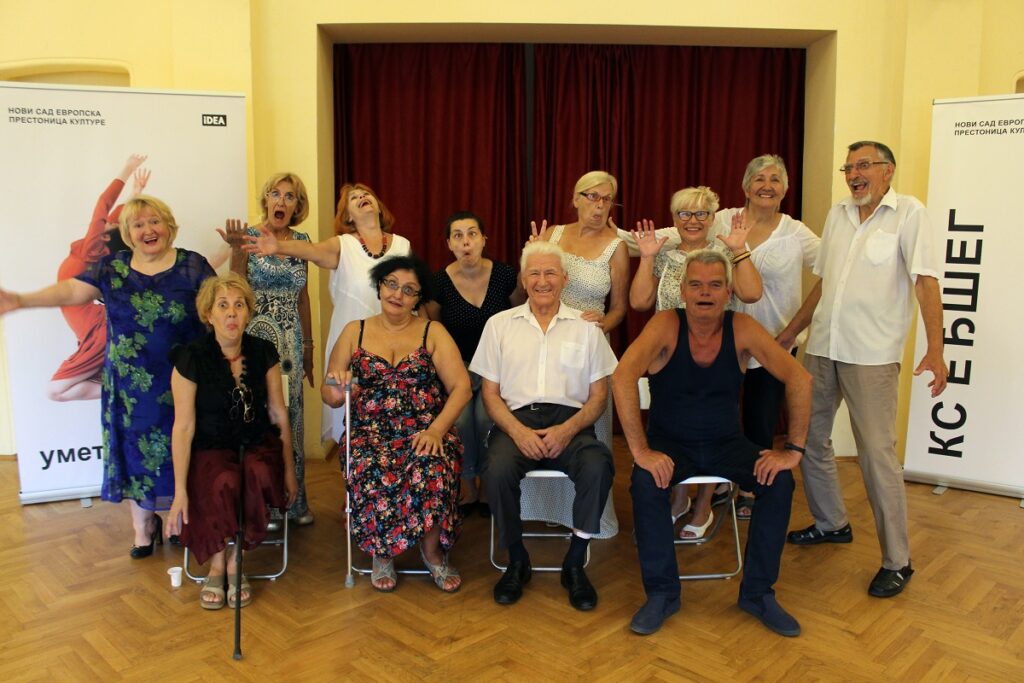
The Cultural Corner’s association project ‘Nurturing Tradition in Vojvodina’ includes the digital narrative which shows how our older citizens dealt with isolation and curfew during the state of emergency. Ten seniors from the Association ‘Seniors’ from Novi Sad, most of whom are included in the activities of the Novi Sad Volunteering Service through series of drama workshops, created their own short stories regarding isolation.
Olga Kovač, founder of the Cultural-Artistic Seniors Society and one of the initiators of the Association ‘Seniors’ and Branka Bajić, dramaturge pedagogist, actress and author of the project (which she implemented with Filip Marinković, theatre and film director) told us how the shootings looked like, what was fun, what was very emotional, how art and culture break the prejudices and affect social and societal conditions.
First, let’s explain how the shooting looked like? How did our older citizens react and how did they deal with this whole project?
Olga: Everyone was happy and pleased that they’re doing something together again. They used to work on the projects regarding drama activities in the past as well. The very preparation, lead by Branka Bajić, actress, was a completely new, inspirational experience. Everyone had fun during the shooting.
Branka: The first phase of the project, before the very shooting, included a series of drama workshops with a group of seniors. The aim of the workshops was for seniors and other participants in the project to meet among themselves and build trust, create everyone’s stories, as well as practice basic public speech and performance. During that phase, we heard the stories and discovered locations for filming each story. We were filming some of them in their flats, some in weekend houses, and some in their cars. We wanted to emphasise the huge difference of being locked in a house with a big yard in Fruška Gora and being locked in a top-floor flat in the middle of the city. In gerontology centres, people had been locked up for months. This group of seniors, all members of the Cultural-Artistic Seniors Society, already have experience regarding public appearances so they weren’t nervous or felt the need to go over scripts and stories many times. It seemed like it was very important to them that someone showed interest and asked them to publicly speak about this topic and share tiny part of their private lives.
I guess when you film something like this it evokes many emotions, from tears to laughter. What was most fun, and what was most emotional?
Olga: There were plenty of emotions, of course. We laughed at the stories of those who were skilled and brave enough to, despite everything, manage to go outside. Their ingenuity and creativity caused hearty laughter. The very thought of the time spent under curfew – about 55 days, caused painful memories, sadness and wish for it to never happen again. Yes, sad were the descriptions of total hopelessness, extreme loneliness and disconnection from society, without a hug or a kiss from any family members or friends. Close contact with another person, hugs, kisses are very important. It gives us positive energy because then we believe that someone cares for us. It also strengthens our immune systems.
Branka: They told me that some of them, during the isolation, tried to ‘trick’ the system by attempting to look younger than 65 in order to get at least to walk for a bit. They would go out wearing vibrant colours, big sunglasses and their hair down. (Dragan, you’ll see him in the video) couldn’t stand sitting in the flat anymore, so he sat in his car in front of the building, he listened to music and played the guitar even though the police was watching him, but he didn’t break any rules. That kind of rebellion, beating the system, is funny, but it actually helped people survive. As the most emotional part I would like to mention that during isolation, an ‘action’ – catch the senior, appeared on social media (reporting seniors who are seen outside when they weren’t allowed to). It caused laughter, people had fun sharing this, but it wasn’t funny to elderly people.
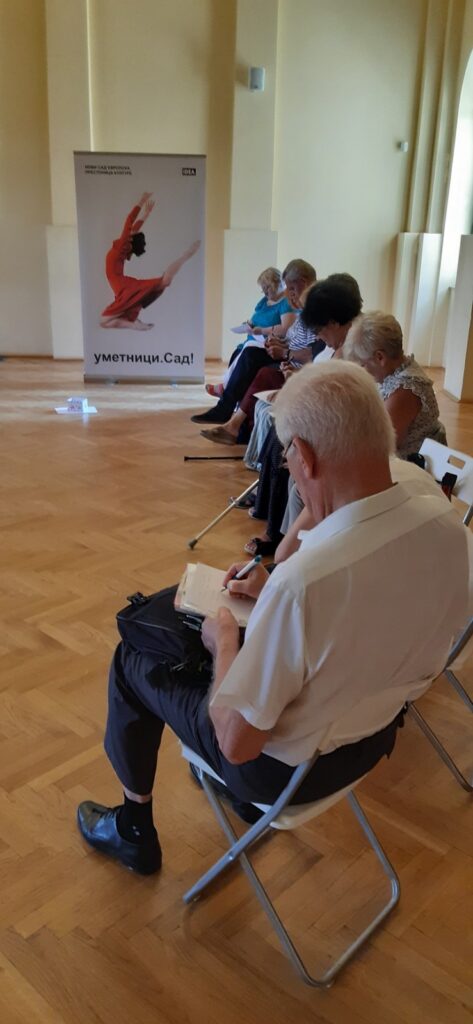
The idea is that the video releases on the International Day of Older Persons, 1 October, i.e. that seniors take over digital space that day. Is the prejudice about the gap between older generations and modern technologies exaggerated?
Olga: Some of them don’t know how to use modern technology. Some of them have family members show them what they want to know. And some of them handle it completely on their own.
Branka: There are many prejudices against older people. They are intertwined, originating from one another. Their digital il(literacy) stems from the prejudices that older people are helpless, that their time has passed, that they are both physically and mentally slow, and that they are incapable of work and unworthy of health care. Anyone, regardless of age, has the right to have basic human rights, lead a dignified and independent life and engage in social and cultural activities. Fight against discrimination and bullying of the older persons includes fight against ‘ageism’ as a structural factor of stereotypization (ageism is discrimination on the basis of someone’s age). Among the many taboos we have in our society, old age and death are the biggest. In the video, you’ll hear Slavica speak about the research she did on people living in the gerontology centre when she was working as a psychologist there. That research explored a huge taboo concerning old age. It also proved that older people still show willingness and interest for love, intimate relationships and sex. Human rights of older people must be protected. Being old should never be a criteria for discluding people from specialized health care or social life. This group of seniors, which you’ll see in the video, is a group of active and educated people. In this collateral damage we managed to notice some positive aspects – willingness to fight against loneliness and isolation. You’ll see Mića who spent the whole isolation period making face masks on his sewing machine. Or Marijana, who mastered using social media. Ljubica wrote and painted regularly. Slavica used handwork to overcome the difficult times. Milva’s husband has been a huge support during the whole retirement period. Danica and Sabrija learned how to play accordion and tamburitza in three months. Gradimir got by with a little help from the garden hoe.
What do we get from hearing their voices on social media, something still mainly occupied by younger generations?
Olga: We expect young people to leave their stereotypes about us behind them after watching the video. We expect them to understand that we’re still interested and capable of engaging in multiple social activities. To understand that old age shouldn’t be the reason to forget that older people exist and
can do many things, and know many things. We hope they stand by us in many activities. The young ones should understand that they too will find themselves old and in a situation like this.
Branka: We deem important that the stories from the isolation hears the wider public, both younger and older people. Also, the idea was to point out the stereotypes related to the old age. The older persons are a heterogeneous social group and there are numerous differences among them. The seniors chosen for this project, in a way, represent a new, changed view on older people. The old age should be recognised as the time of difference, just as any other age. One of the ways to accomplish this is to reconsider and encourage a more realistic process of getting old in traditional media and social media. By this, I mainly mean the stereotypical image – not only an image of a person with a hunched over posture and a stick in their hand, but also those magazines representing old people who age ‘successfully’ and ‘glamorously’, which is, of course, financially unattainable for many people. Also, we noticed that Facebook is becoming predominantly used by older people. By sharing their stories on social media, we believe we’ll influence not just younger generations but wider audience as well, the ones who also believe in the stereotypes.
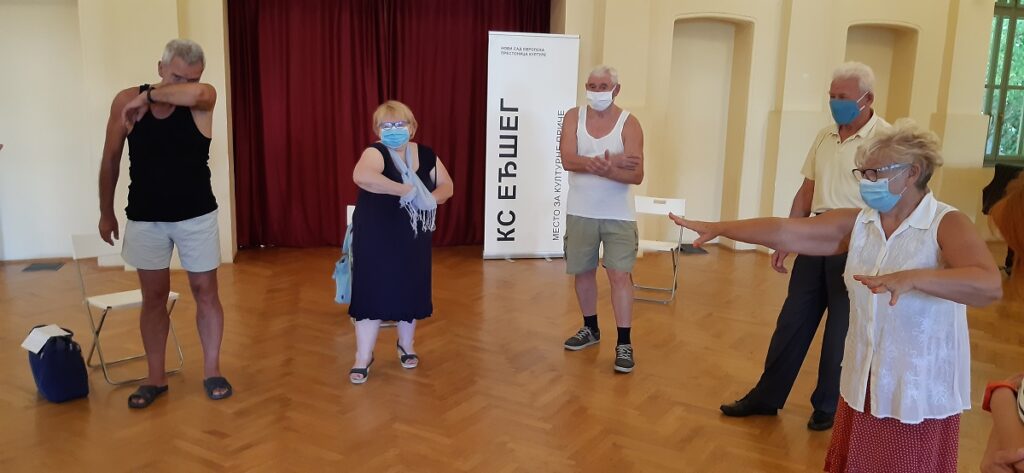
In fact, the main goal of this project is to emphasise their position. Let’s talk statistics, what are the official information when talking position of old people?
Olga: There are 1.89 million people over 60 in Serbia. Most of them have extremely low incomes or they live on social security alone, which is not enough. One part of them doesn’t have any kind of income because they are either not old enough to retire or they’ve never had a job. Their position is not how it’s supposed to be. They are the ones who worked and build this country and they deserve better care than the one they get. Unfortunately, both the society and their families exclude them from everyday life.
Branka: The age profile of our society is changing rapidly. The Republic of Serbia is one of the oldest countries based on the age profile. Until 2030, the percentage of people older than 65 is going to be 20, which is almost one out of four citizens. Despite all changes in the age structure of our society, ‘ageism’ is still common, as well as stereotypes and negative opinions on the older persons. This can cause damage to the individuals in two ways: First, when stereotypes result in prejudices and discrimination, which can be felt both directly and indirectly; second, when stereotypes shape our ways of thinking and feeling about getting old ourselves. Those stereotypes and points of view reflect on the language we use – the one we use both in our everyday lives and in media and politics. Narratives promoting the old age as a period of inevitable fall, crisis, confrontation between older and younger generations and conflicts over resources and power, are definitely making the abovementioned problems even worse. We must confront this. We believe art and theatre are one of the possible ways to make a change.
Having in mind that epidemiological measures were different across countries, and that ours were very strict, how do our older citizens, who were in isolation the longest, look at this? What kind of consequences can this have on them and their psyche?
Olga: They are sad, surprised and hurt. Being in absolute isolation for almost two months is very difficult for older people. Because of their health conditions, it’s necessary for them to take morning and night walks. To hang out with friends and family. To have the freedom to leave their flats and be outside whenever they want to. The consequences of this curfew are already visible. Some of them will never go out again because they are out of shape now, and some because they are afraid to do so due to what they have seen and heard on TV. A lot of them are depressed or with worse chronic conditions, because they couldn’t see their doctors during the pandemic. More consequences will be visible in the years to come.
Branka: The situation was similar in other countries too, and they also had to solve the problem of how to protect older people and not keep them isolated for months. They too had to make urgent decisions in order to stop the virus from spreading and infecting people. The government in Serbia hardly consulted the advisory bodies or had any talks with the affected and most vulnerable groups. However, they know how important these processes are in order to satisfy the basic needs of people and maintain their support and understanding. It seemed as if this pandemic made older people look helpless, dependant and uneducated, or simply – a burden to others. This cannot happen again. Just because they’re covid-19 sensitive, doesn’t mean that this kind of disrespectful rhetoric is allowed. We promote the strengthening of older persons, making them active part of the society, especially when it comes to the decisions that affect their lives. In April, the German Academy of Sciences published an interesting study which alarmed that the separation of certain society groups for the sake of ‘their own protection’ is harmful due to the psychological influence it has on them. In this video, you’ll have a chance to hear our seniors talk about how they were separated against their will and deprived of their rights to make independent decisions.
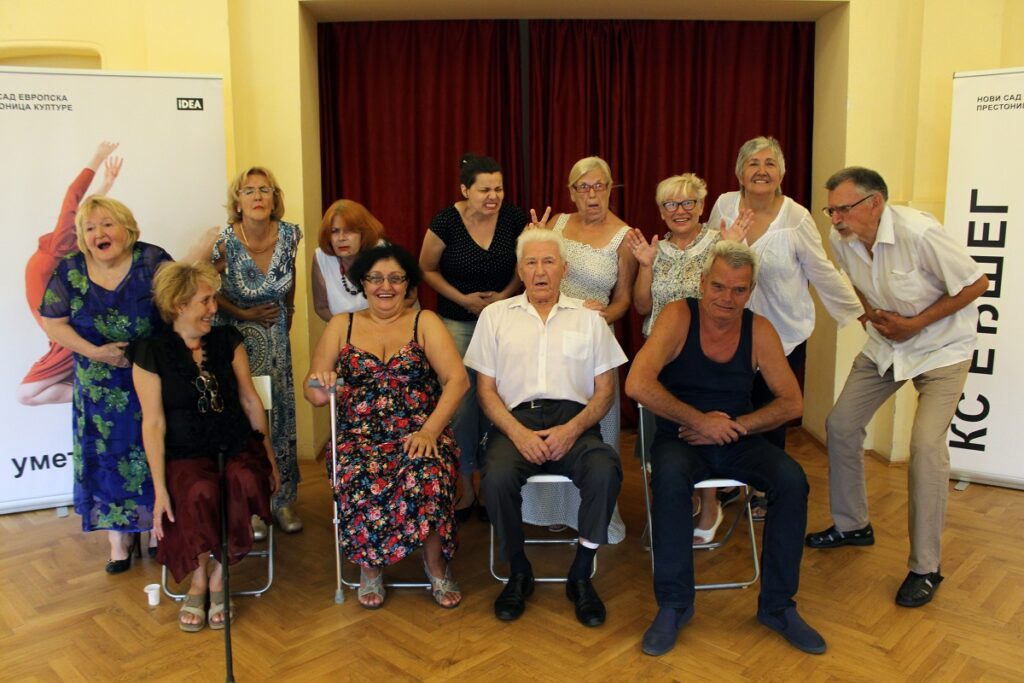
To what extent can projects like this contribute to making significant changes? Can art and culture change certain social attitudes and circumstances?
Olga: Yes, they can help a lot. First, they can help change the lack of care younger people have for the older ones. This can help make a traditional family priority again, thus more attention will be paid to old people. Making older people part of the cultural-artistic communities will change the quality of their lives for the better.
Branka: Art and theatre can snap a person out of mental lethargy by raising the awareness of their social position, thus making them actively conscious, not just partially conscious. Engaged art can point out to certain social problems and combined with other engaged social-political means, organisations and institutions, it can affect the social system and finally change it. The goal of this kind of art we’re doing is to constantly stay vital and relevant, and to always question the current moment and contemporary society. Having done a lot of theatre projects with different people in the past 15 years, I often encounter some of them and often hear them say ‘Those projects meant a lot to me, they helped me realise and feel certain things.’ The theatre sparks changes, because the theatre speaks the truth. As Grotowski used to say, even if only one person sees the truth, it is enough and the change is significant. I still believe in this.
This is one of 42 projects that received funds in the Public Call to Novi Sad artists and associations within the ‘Artists. Now!’ project aimed at strengthening the cultural scene and raising its capacities through a network of cultural stations.
